Inside The New York Botanical Garden
Posted in Exhibitions, The Edible Garden on July 28 2009, by Plant Talk

The coconut palm (Cocos nucifera) is often called the “tree of life” in honor of its varied uses. The hairy, brown-husked seeds contain a white meat that is a popular ingredient in sweet and savory recipes. It is grated and blended with water to create coconut milk and pressed to produce coconut oil—both useful cooking ingredients. The coconut water inside the seed is also a refreshing and highly nutritious drink. See this plant and more on the Edible Plant Tour during The Edible Garden.
Posted in Gardening Tips, The Edible Garden on July 27 2009, by Sonia Uyterhoeven
 |
Sonia Uyterhoeven is Gardener for Public Education. Join her each weekend for home gardening demonstrations on a variety of topics in the Home Gardening Center. |
 Edible flowers are not to everyone’s taste. Some are wonderfully fragrant and delicious, others are lemony, some are spicy and tangy, others taste green and weedy, and some even taste fishy. Edible flowers are a good way to add color and seasoning to your summer salads. They brighten up herb butters and dress up desserts. When added to a bowl of sugar or to a bottle of vinegar and left to steep for several weeks, they create inventive, tasty combinations.
Edible flowers are not to everyone’s taste. Some are wonderfully fragrant and delicious, others are lemony, some are spicy and tangy, others taste green and weedy, and some even taste fishy. Edible flowers are a good way to add color and seasoning to your summer salads. They brighten up herb butters and dress up desserts. When added to a bowl of sugar or to a bottle of vinegar and left to steep for several weeks, they create inventive, tasty combinations.
Some flowers need a little bit of preparation before they are ready to tickle your tongue. The sepals, stamens, and stigmas of some flowers such as borage (Borago), tulips (Tulipa), and daylilies (Hemerocallis) should be removed before eating—only the petals are eaten.
Pinks (Dianthus) and roses (Rosa) can have a bitter white edge at the base of the petal, which should be cut off before using. Some marigolds (Tagetes) are divine, but others are not—try the lemon-flavored Tagetes tenuifolia ‘‘Tangerine Gem’ and ‘Lemon Gem’.
For the best flavor, harvest flowers either when they are in bud or have just opened. Harvest on a dry day, mid-morning after the dew has evaporated and before it gets too hot. It is best to use flowers when they are fresh. They can be refrigerated for several days, but they do not dry or freeze well.
Read More
Posted in Exhibitions, The Edible Garden on July 24 2009, by Plant Talk
 |
Jessica Blohm is Interpretive Specialist for Public Education. |
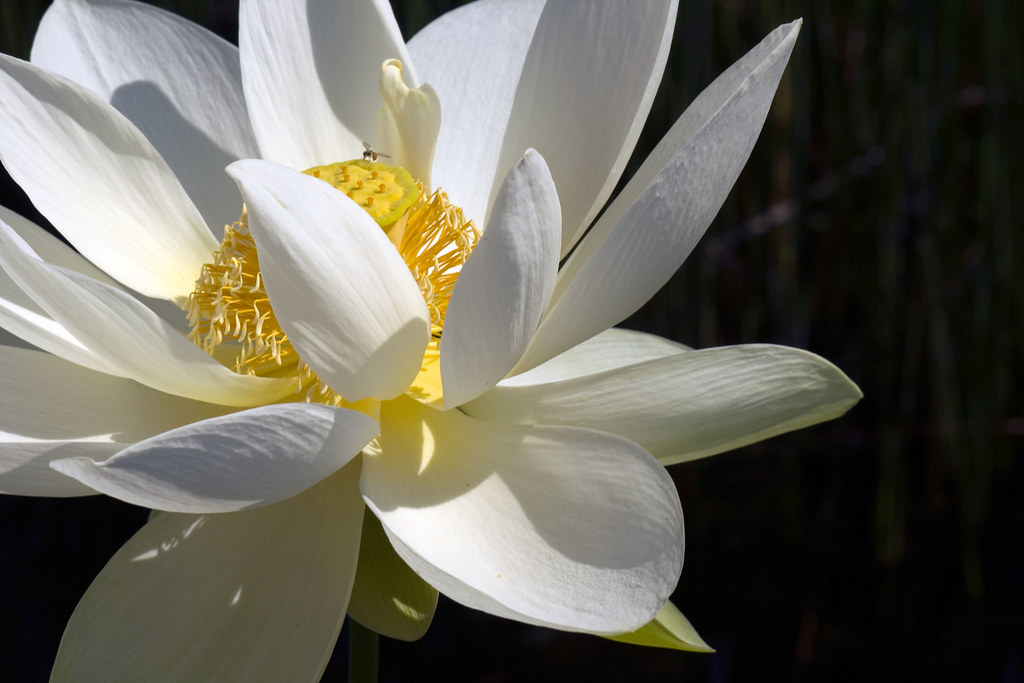 The Garden’s 250-acre National Historic Landmark landscape includes thousands of edible trees and plants. Through signs and audio interpretation, visitors can learn about 57 of these edible plants on the Edible Plant Tour during The Edible Garden.
The Garden’s 250-acre National Historic Landmark landscape includes thousands of edible trees and plants. Through signs and audio interpretation, visitors can learn about 57 of these edible plants on the Edible Plant Tour during The Edible Garden.
The tour features an array of plants, from the tropical coconut palm (Cocos nucifera) to our native sugar maple (Acer saccharum), source of that favorite breakfast topping, maple syrup. The tour also offers visitors a chance to share their stories and traditions about various plants and to listen to stories from other visitors, an exciting new feature.
Lotus (Nelumbo), pictured here, which has edible flowers, leaves, stems, and seeds, is just one of the many interesting plants featured on the Edible Plant Tour. Through the interpretive signage on the tour you would learn that the flower petals of the lotus can be used as a garnish and the stamens dried to create a fragrant tea. The leaves are used in infusions or to wrap other foods, and the seeds are eaten whole or combined with sugar to yield the paste found in pastries such as mooncakes. Its rhizomes or underground stems (often called lotus roots) can be stir-fried, braised, deep-fried, or even pickled in Asian cuisines.
See this plant and many others up close and personal when you visit The Edible Garden.
Posted in The Edible Garden on July 23 2009, by Plant Talk
 |
Sunny Anderson is host of Food Network’s Cooking for Real. She will be presenting at the Conservatory Kitchen during this evening’s Edible Evening. |
I’ve often thought of myself as a person who does the “small things” that make a difference because they do add up. So I satisfied my foodie need to be green by becoming a locavore, and I do my best to visit local farmers markets for produce. Farmers are the most friendly of purveyors, and a weekend just doesn’t feel complete without a stroll looking for the best produce.
As a locavore, I also have always talked of wanting to garden but knew I’d never have to ante up because, well, I didn’t have a piece of Earth to call my own.
Things changed earlier this year when I moved into a place in Brooklyn with a tiny patch of land in the backyard. I knew then, looking at the dirt and weeds, that while I wouldn’t have to go looking for a heavy equipment rental company to hire a small excavator to dig my patch of land, my mouth had still written a check my hands would soon sow.
Here’s the thing, gardening always looks so clean and pleasant in magazines and on television, and I never met a farmer at the market who didn’t have a twinkle in his or her eye, but when I began to garden it didn’t look or feel as I pictured it. Not once did I put on khakis with a denim button-down shirt over a white tank top. My tools are constantly dirty, and I also gave up on using my gloves because I somehow manage to get dirt inside them and they just don’t feel as good as my natural grip.
It also took forever to get the soil ready on the first day. I guess I thought I’d simply sow some seeds and then wait. I never thought about weeds and mulching, pruning, and watering. Also, no one ever tells you about the obsession with the weather you obtain or the sleepless nights thinking about if the next day will be the day you see a sprout. Is it possible to have gardening OCD? When I was actually happy and relieved that it was raining during summer is when I knew I was on my way to becoming a backyard-avore.
Read More
Posted in Exhibitions, NYBG in the News, The Edible Garden on July 23 2009, by Plant Talk
 |
Nick Leshi is Associate Director of Public Relations and Electronic Media. |
Subscribers to Sirius Satellite Radio and regular listeners to Martha Stewart Living Radio will be thrilled to know that all the programming for Martha’s shows today, Thursday, July 23, will be broadcast live from The New York Botanical Garden. Visitors who do not currently have satellite radio subscriptions will get a tease of what they’re missing when they walk through the Botanical Garden and see Martha’s team of lifestyle experts broadcasting live.
All the hosts will be here, teaching, advising, and inspiring their audience about topics ranging from gardening, food, and design to health and wellness: Betsy Karetnick and Kim Fernandez of Morning Living, Terri Trespecio of Whole Living, Sandy Gluck of Everyday Food, Mario Bosquez of Living Today, Lucinda Scala Quinn of Eat Drink, and Andrew Beckman and Tony Bielaczyc of Homegrown.
Pass by the back of the Jane Watson Irwin Perennial Garden, near Martha Stewart’s Culinary Herb Garden, to see and hear the broadcast. Several Botanical Garden experts will be on hand as guests on the shows throughout the day, talking about the various highlights and components of The Edible Garden, the summer-long exhibitions at The New York Botanical Garden.
For more information, visit Martha Stewart Living Radio. And to purchase tickets for The Edible Garden, click here.
Posted in Uncategorized on July 22 2009, by Plant Talk
Leda Meredith holds a Certificate in Ethnobotany from the Botanical Garden, is author of Botany, Ballet, & Dinner from Scratch: A Memoir with Recipes, and hosts her own blog, Leda’s Urban Homestead.
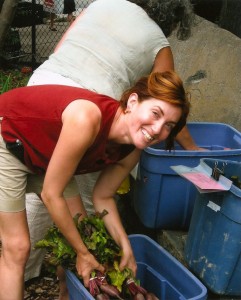 When I set out to eat almost exclusively food grown within 250 miles of New York City, I had a lot of questions. I knew that eating a local-foods diet would reduce my carbon footprint as well as support small local farms and the local economy. I knew from my visits to farmers markets and from growing vegetables in a community garden how fabulous fresh food picked at its peak could be. But…
When I set out to eat almost exclusively food grown within 250 miles of New York City, I had a lot of questions. I knew that eating a local-foods diet would reduce my carbon footprint as well as support small local farms and the local economy. I knew from my visits to farmers markets and from growing vegetables in a community garden how fabulous fresh food picked at its peak could be. But…
All of the other locavores I’d read about, including Barbara Kingsolver and Michael Pollan, had advantages over me when it came to eating local. They lived in a mild climate with a longer agricultural season, or had huge gardens or even farms. What I wanted to find out was could it be done by someone living in a tiny apartment on a limited budget, and with a hectic, multi-employer urban lifestyle? And what would I eat in winter?
I discovered that it is completely possible to eat a deliciously varied and healthy local foods diet in NYC without breaking the bank or requiring a 28-hour day. Local, organic food can be pricey, but it doesn’t have to be. There are ways to make a local foods diet almost as convenient as picking up the phone to order takeout or delivery.
Read More
Posted in Learning Experiences, People on July 21 2009, by Plant Talk
 |
Ashley Burke is a second-year student in the School of Professional Horticulture. She is doing her required six-month internship at the High Line in Manhattan, a recently completed elevated public park built on a former rail bed. The School’s internship program is designed to allow students to synthesize and apply what they’ve learned, expand their skills by providing further training in a professional horticulture venue, and expose them to the multiple facets of the field. Ashley sent us this report. |
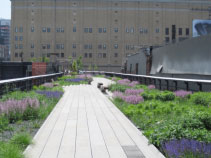 Interning at the High Line, a park on the Lower Westside of Manhattan that opened on June 9, has given me an unparalleled opportunity to observe and learn about how a city park is created.
Interning at the High Line, a park on the Lower Westside of Manhattan that opened on June 9, has given me an unparalleled opportunity to observe and learn about how a city park is created.
I began working at the park in mid-April and as such, have been exposed to various elements of the process. Some of my responsibilities have included compiling a master plant list; verifying what has been planted; creating plant identification cards to be used by the public, with plant names, cultural information, native range, and where it is located in the park; and even selecting horticulture tools. Of course, I also had hands-on plant work: The week before opening, we raced against time to weed, water, and prune to get the park ready for visitors.
I also worked extensively with the plans that were drawn up by the landscape architects, field operations, and the landscape designer, Piet Oudolf (who co-designed the current Seasonal Walk at The New York Botanical Garden), and this has allowed me to familiarize myself with the plants being used. Part of this has been to check that each plant species is properly identified, the name is spelled correctly, and that the plants are located where they are indicated on the plan. Through my experiences, I am learning that one cannot design properly without being able to identify the materials one works with.
Read More
Posted in Gardening Tips on July 20 2009, by Sonia Uyterhoeven
 |
Sonia Uyterhoeven is Gardener for Public Education. Join her each weekend for home gardening demonstrations on a variety of topics in the Home Gardening Center. |
The rule of thumb with most herbs is the more you neglect them the better they grow. Most people kill their herbs with kindness by over-watering and over-fertilizing them. If you care too much for your herbs, you will only end up with powdery mildew and rotting leaves.
Herbs generally thrive in well-drained soil and full sun. The only work they require is for you to pinch them back so that they don’t get leggy and go to flower. The handfuls left from pinching back can go straight from the garden into the kitchen.
While most herbs prefer a sunny site to grow in, some herbs thrive in a slightly shady spot. Some candidates for afternoon shade are parsley (Petroselinum), mints (Mentha), lemon balm (Melissa), and tarragon (Artemisia dracunculus).
Cilantro (Coriandrum), chervil (Anthriscus), and dill (Anethum) are short-lived annuals. They go to seed after a few weeks, so multiple sowings a few weeks apart will ensure a good supply. They prefer the cooler seasons of spring and fall.
Read More
Posted in Exhibitions, The Edible Garden on July 17 2009, by Plant Talk
 Gregory Long is President and CEO of The New York Botanical Garden.
Gregory Long is President and CEO of The New York Botanical Garden.
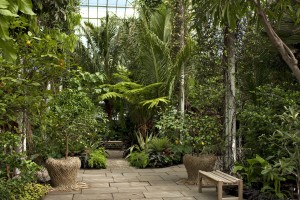 The Edible Garden is meant to inspire visitors and to teach them about growing great food. One of the 11 exhibits featured in the summer-long celebration, Tropical Fruits, Roots, and Shoots in the Enid A. Haupt Conservatory, not only delivers on both counts but is a real showstopper as well, with more than 280 tropical plants and fruit-bearing trees, and dozens in flower or fruit right now.
The Edible Garden is meant to inspire visitors and to teach them about growing great food. One of the 11 exhibits featured in the summer-long celebration, Tropical Fruits, Roots, and Shoots in the Enid A. Haupt Conservatory, not only delivers on both counts but is a real showstopper as well, with more than 280 tropical plants and fruit-bearing trees, and dozens in flower or fruit right now.
Francisca Coelho, Senior Curator and Associate Vice President for Glasshouses and Exhibitions, has outdone herself with this tropical edibles exhibit, which features lush, elaborate displays of rare and beautiful vegetation, including everyday favorites like coffee, coconut, and cinnamon growing alongside more unusual fare like passion fruit, tamarind, and açai.
 Fran presents a global as well as a personal view of foods. You can see and learn about some of the world’s basic food crops such as rice, corn, and sorghum—staples many people have never seen in their plant form—as well as witness 42 kinds of hot peppers, Capsicum (and a handful of sweet varieties). Fran grew up eating food accented with peppers in her native Trinidad. In the Caribbean, peppers are showy and spicy, and the same plant can produce fruits of widely divergent colors. For instance, the Bolivian rainbow pepper starts off purple and then turns yellow and then orange and then red. “Green and red peppers are pretty boring. Gardeners should go for a variety on both color and taste,” Fran says. Some of her favorite recipes utilizing peppers are posted on our Edible Garden Web pages.
Fran presents a global as well as a personal view of foods. You can see and learn about some of the world’s basic food crops such as rice, corn, and sorghum—staples many people have never seen in their plant form—as well as witness 42 kinds of hot peppers, Capsicum (and a handful of sweet varieties). Fran grew up eating food accented with peppers in her native Trinidad. In the Caribbean, peppers are showy and spicy, and the same plant can produce fruits of widely divergent colors. For instance, the Bolivian rainbow pepper starts off purple and then turns yellow and then orange and then red. “Green and red peppers are pretty boring. Gardeners should go for a variety on both color and taste,” Fran says. Some of her favorite recipes utilizing peppers are posted on our Edible Garden Web pages.
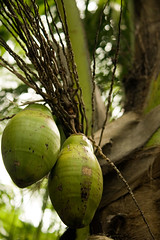 While the exhibit features plants that have edible parts, many more plants beyond peppers are ornamental. Gardeners have manipulated edible plants over the centuries to hybridize ornamentals. Fran notes: “When we garden in the Caribbean, we stick ornamentals among the food plants.” Purple seems to be an attention-getting, commanding, vibrant color with the most captivating foliage. Cordyline fruticosa ‘Negri’, the ti (pronounced “tie”) plant has deep purple, almost black, leaves. It is often used as a border plant in the Caribbean and is also used in cooking: food is wrapped in the large, thin leaves and dropped into a broth, stew, or soup. Other ornamental food plants include the grain amaranth (Amaranthus), which was used by Aztecs as cereal, and shiso (Perilla), with its deep purple, fluted, undulating leaves, used as a seasoning and as a tea.
While the exhibit features plants that have edible parts, many more plants beyond peppers are ornamental. Gardeners have manipulated edible plants over the centuries to hybridize ornamentals. Fran notes: “When we garden in the Caribbean, we stick ornamentals among the food plants.” Purple seems to be an attention-getting, commanding, vibrant color with the most captivating foliage. Cordyline fruticosa ‘Negri’, the ti (pronounced “tie”) plant has deep purple, almost black, leaves. It is often used as a border plant in the Caribbean and is also used in cooking: food is wrapped in the large, thin leaves and dropped into a broth, stew, or soup. Other ornamental food plants include the grain amaranth (Amaranthus), which was used by Aztecs as cereal, and shiso (Perilla), with its deep purple, fluted, undulating leaves, used as a seasoning and as a tea.
The biggest surprises? The cashew (Anacardium occidentale), which comes from the same plant family as poison ivy and mango. Wrapped in a poisonous seed coat to protect against nature’s predators, the cashew nut is found at the end of a fleshy, flashy, bright-red fruit. And the ice cream bean (Inga jinicuil), which has a seed that when mature is fat and filled with a creamy pulp that tastes like vanilla ice cream.
You must come visit The Edible Garden and Fruits, Roots, and Shoots to see for yourself. I believe there has never before been such a display on such a scale.
Posted in Exhibitions, The Edible Garden on July 16 2009, by Plant Talk
 |
Kristin Schleiter is Curator of Outdoor Gardens and Herbaceous Collections. |
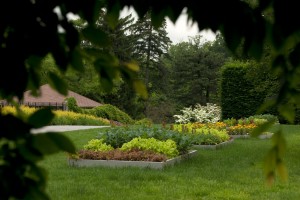 Have you been toying with the idea of starting a vegetable garden but you aren’t sure just how to do it? The Beginner’s Vegetable Garden, across from the Ruth Rea Howell Family Garden, is the perfect place to learn the basics. We planted popular vegetable varieties like ‘Early Girl’ tomatoes and jalapeno peppers in simple raised beds that receive sun all day long. We used a number of different easy-to-find support structures to give you ideas that you might want to try at home.
Have you been toying with the idea of starting a vegetable garden but you aren’t sure just how to do it? The Beginner’s Vegetable Garden, across from the Ruth Rea Howell Family Garden, is the perfect place to learn the basics. We planted popular vegetable varieties like ‘Early Girl’ tomatoes and jalapeno peppers in simple raised beds that receive sun all day long. We used a number of different easy-to-find support structures to give you ideas that you might want to try at home.
We are growing cucumbers on a frame, a large square grid of heavy gauge wire that is propped up on one side. The frame allows the cucumbers to hang down freely from the vines ensuring perfectly shaped vegetables. It also increases air circulation around the plant, which helps to minimize diseases like mildew. Cucumbers and squash both can take up a lot of real estate, so if you have limited space, this frame lets you grow them and still have room for other plants in the garden.
Pole bean seeds are planted at the base of bean towers and spirals, which will offer the plants strong support so they can grow tall, which allows for an easy harvest while again ensuring good air circulation. When your beans reach the top of their support, snip off the growing tip to encourage the plant to produce side branches. It is best not to work around bean plants or to pick beans when they are wet to prevent the spread of disease.
Read More
















